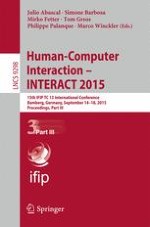2015 | Buch
Human-Computer Interaction – INTERACT 2015
15th IFIP TC 13 International Conference, Bamberg, Germany, September 14-18, 2015, Proceedings, Part III
herausgegeben von: Julio Abascal, Simone Barbosa, Mirko Fetter, Tom Gross, Philippe Palanque, Marco Winckler
Verlag: Springer International Publishing
Buchreihe : Lecture Notes in Computer Science
